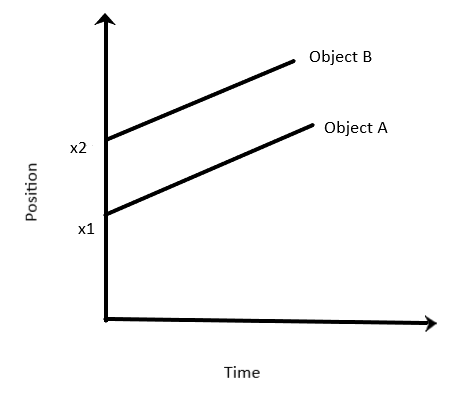
The graph shown below represent:

A. A and B are moving with the same velocity in opposite directions.
B. Velocity of B is more than A in the same direction.
C. Velocity of A is more than B in the same direction.
D. Velocity of A and B is equal in the same direction.
Answer
217.8k+ views
Hint: Here the position-time graph of two objects is given. We know that the slope of position time graph gives velocity and we all can identify positive slope and negative slope. And by knowing the direction of slope we can say the exact direction of objects too.
Complete step by step solution:
We know that the slope of the position – time graph is velocity. In this question the position-time graph of two objects is given. The graph is a straight line with a positive slope. The graph of both objects is a straight line parallel to each other. We know that slope is the same for parallel lines. That is, velocity of A and B are equal and in the same direction.
Hence, the correct answer is option D.
Additional information: For a particle in motion, we can draw mainly three types of graphs:
- Position- time graph
- Velocity- time graph
- Acceleration-time graph
From these we can obtain much information about the particle. Like we get to know about the slope and slope of a position-time graph gives velocity of the particle and slope of velocity-time graph gives acceleration. Even the shape of the graph gives many details.
Notes: Observe that slope is the same for parallel lines. Position time of an object shows the position of the particle with respect to time. If the position-time graph is constant means that the particle is at rest. If the slope of the position time graph is negative it means negative velocity. If the position time graph of an object is a curved line, then it means there is change in velocity or we can say that the particle has acceleration.
Complete step by step solution:
We know that the slope of the position – time graph is velocity. In this question the position-time graph of two objects is given. The graph is a straight line with a positive slope. The graph of both objects is a straight line parallel to each other. We know that slope is the same for parallel lines. That is, velocity of A and B are equal and in the same direction.
Hence, the correct answer is option D.
Additional information: For a particle in motion, we can draw mainly three types of graphs:
- Position- time graph
- Velocity- time graph
- Acceleration-time graph
From these we can obtain much information about the particle. Like we get to know about the slope and slope of a position-time graph gives velocity of the particle and slope of velocity-time graph gives acceleration. Even the shape of the graph gives many details.
Notes: Observe that slope is the same for parallel lines. Position time of an object shows the position of the particle with respect to time. If the position-time graph is constant means that the particle is at rest. If the slope of the position time graph is negative it means negative velocity. If the position time graph of an object is a curved line, then it means there is change in velocity or we can say that the particle has acceleration.
Recently Updated Pages
Arithmetic, Geometric & Harmonic Progressions Explained

Cartesian Form of Vector Explained: Formula, Examples & Uses

Apparent Frequency Explained: Formula, Uses & Examples

Calorimetry: Definition, Principles & Calculations

Centrifugal Force Explained: Definition, Formula & Examples

Charge in a Magnetic Field: Definition, Formula & Examples

Trending doubts
JEE Main 2026: Application Form Open, Exam Dates, Syllabus, Eligibility & Question Papers

Derivation of Equation of Trajectory Explained for Students

Hybridisation in Chemistry – Concept, Types & Applications

Understanding the Angle of Deviation in a Prism

Understanding Collisions: Types and Examples for Students

How to Convert a Galvanometer into an Ammeter or Voltmeter

Other Pages
JEE Advanced Marks vs Ranks 2025: Understanding Category-wise Qualifying Marks and Previous Year Cut-offs

Units And Measurements Class 11 Physics Chapter 1 CBSE Notes - 2025-26

NCERT Solutions For Class 11 Physics Chapter 8 Mechanical Properties Of Solids

Motion in a Straight Line Class 11 Physics Chapter 2 CBSE Notes - 2025-26

NCERT Solutions for Class 11 Physics Chapter 7 Gravitation 2025-26

Understanding Atomic Structure for Beginners




